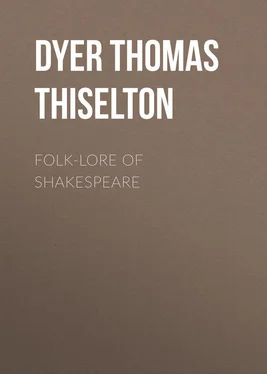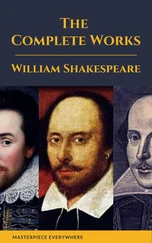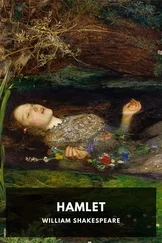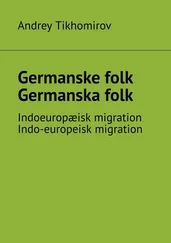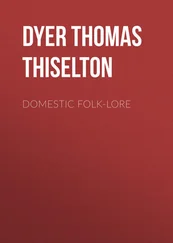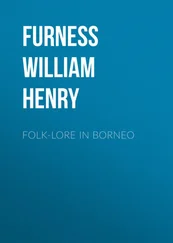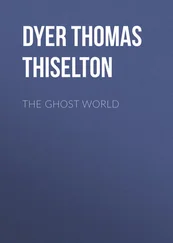Thomas Dyer - Folk-lore of Shakespeare
Здесь есть возможность читать онлайн «Thomas Dyer - Folk-lore of Shakespeare» — ознакомительный отрывок электронной книги совершенно бесплатно, а после прочтения отрывка купить полную версию. В некоторых случаях можно слушать аудио, скачать через торрент в формате fb2 и присутствует краткое содержание. Жанр: foreign_antique, foreign_prose, на английском языке. Описание произведения, (предисловие) а так же отзывы посетителей доступны на портале библиотеки ЛибКат.
- Название:Folk-lore of Shakespeare
- Автор:
- Жанр:
- Год:неизвестен
- ISBN:нет данных
- Рейтинг книги:4 / 5. Голосов: 1
-
Избранное:Добавить в избранное
- Отзывы:
-
Ваша оценка:
- 80
- 1
- 2
- 3
- 4
- 5
Folk-lore of Shakespeare: краткое содержание, описание и аннотация
Предлагаем к чтению аннотацию, описание, краткое содержание или предисловие (зависит от того, что написал сам автор книги «Folk-lore of Shakespeare»). Если вы не нашли необходимую информацию о книге — напишите в комментариях, мы постараемся отыскать её.
Folk-lore of Shakespeare — читать онлайн ознакомительный отрывок
Ниже представлен текст книги, разбитый по страницам. Система сохранения места последней прочитанной страницы, позволяет с удобством читать онлайн бесплатно книгу «Folk-lore of Shakespeare», без необходимости каждый раз заново искать на чём Вы остановились. Поставьте закладку, и сможете в любой момент перейти на страницу, на которой закончили чтение.
Интервал:
Закладка:
In “Romeo and Juliet” (i. 4) she is known by the more familiar appellation, Queen Mab. “I dream’d a dream to-night,” says Romeo, whereupon Mercutio replies, in that well-known famous passage —
“O, then, I see Queen Mab hath been with you,”
this being the earliest instance in which Mab is used to designate the fairy queen. Mr. Thoms 7 7 “Three Notelets on Shakespeare,” pp. 100-107.
thinks that the origin of this name is to be found in the Celtic, and that it contains a distinct allusion to the diminutive form of the elfin sovereign. Mab , both in Welsh and in the kindred dialects of Brittany, signifies a child or infant, and hence it is a befitting epithet to one who
“comes
In shape no bigger than an agate-stone
On the fore-finger of an alderman.”
Mr. Keightley suggests that Mab may be a contraction of Habundia, who, Heywood says, ruled over the fairies; and another derivation is from Mabel, of which Mab is an abbreviation.
Among the references to Queen Mab we may mention Drayton’s “Nymphidia:”
“Hence Oberon, him sport to make
(Their rest when weary mortals take,
And none but only fairies wake),
Descendeth for his pleasure:
And Mab, his merry queen, by night
Bestrides young folks that lie upright,” etc.
Ben Jonson, in his “Entertainment of the Queen and Prince at Althrope,” in 1603, describes as “tripping up the lawn a bevy of fairies, attending on Mab, their queen, who, falling into an artificial ring that there was cut in the path, began to dance around.” In the same masque the queen is thus characterized by a satyr.
“This is Mab, the mistress fairy,
That doth nightly rob the dairy,
And can help or hurt the cherning
As she please, without discerning,” etc.
Like Puck, Shakespeare has invested Queen Mab with mischievous properties, which “identify her with the night hag of popular superstition,” and she is represented as
“Platting the manes of horses in the night.”
The merry Puck, who is so prominent an actor in “A Midsummer-Night’s Dream,” is the mischief-loving sprite, the jester of the fairy court, whose characteristics are roguery and sportiveness. In his description of him, Shakespeare, as Mr. Thoms points out, “has embodied almost every attribute with which the imagination of the people has invested the fairy race; and has neither omitted one trait necessary to give brilliancy and distinctness to the likeness, nor sought to heighten its effect by the slightest exaggeration. For, carefully and elaborately as he has finished the picture, he has not in it invested the ‘lob of spirits’ with one gift or quality which the popular voice of the age was not unanimous in bestowing upon him.” Thus (ii. 1) the fairy says:
“Either I mistake your shape and making quite,
Or else you are that shrewd and knavish sprite,
Call’d Robin Goodfellow: are you not he
That frights the maidens of the villagery;
Skim milk; and sometimes labour in the quern,
And bootless make the breathless housewife churn;
And sometime make the drink to bear no barm;
Mislead night-wanderers, laughing at their harm?
Those that Hobgoblin call you, and sweet Puck,
You do their work, and they shall have good luck:
Are not you he?”
The name “Puck” was formerly applied to the whole race of fairies, and not to any individual sprite — puck , or pouke , being an old word for devil, in which sense it is used in the “Vision of Piers Plowman:”
“Out of the poukes pondfold
No maynprise may us fecche.”
The Icelandic puki is the same word, and in Friesland and Jutland the domestic spirit is called Puk by the peasantry. In Devonshire, Piskey is the name for a fairy, with which we may compare the Cornish Pixey. In Worcestershire, too, we read how the peasantry are occasionally “poake-ledden,” that is, misled by a mischievous spirit called poake . And, according to Grose’s “Provincial Glossary,” in Hampshire they give the name of Colt-pixey to a supposed spirit or fairy, which, in the shape of a horse, neighs, and misleads horses into bogs. The Irish, again, have their Pooka, 8 8 See Croker’s “Fairy Legends of South of Ireland,” 1862, p. 135.
and the Welsh their Pwcca – both words derived from Pouke or Puck. Mr. Keightley 9 9 “Fairy Mythology,” 1878, p. 316.
thinks, also, that the Scottish pawkey , sly, knowing, may belong to the same list of words. It is evident, then, that the term Puck was in bygone years extensively applied to the fairy race, an appellation still found in the west of England. Referring to its use in Wales, “there is a Welsh tradition to the effect that Shakespeare received his knowledge of the Cambrian fairies from his friend Richard Price, son of Sir John Price, of the Priory of Brecon.” It is even claimed that Cwm Pwcca, or Puck Valley, a part of the romantic glen of the Clydach, in Breconshire, is the original scene of the “Midsummer-Night’s Dream.” 10 10 Wirt Sikes’s “British Goblins,” 1880, p. 20.
Another of Puck’s names was Robin Goodfellow, and one of the most valuable illustrations we have of the “Midsummer-Night’s Dream” is a black-letter tract published in London, 1628, under the title of “Robin Goodfellow: His Mad Pranks, and Merry Jests, full of honest mirth, and is a fit medicine for melancholy.” 11 11 This is reprinted in Hazlitt’s “Fairy Tales, Legends, and Romances, illustrating Shakespeare and other English Writers,” 1875, p. 173.
Mr. Halliwell-Phillipps, 12 12 “Illustrations of the Fairy Mythology of the Midsummer-Night’s Dream,” printed for the Shakespeare Society, p. viii.
speaking of Robin Goodfellow, says, “there can be no doubt that in the time of Shakespeare the fairies held a more prominent position in our popular literature than can be now concluded from the pieces on the subject that have descended to us.” The author of “Tarlton’s News out of Purgatory,” printed in 1590, assures us that Robin Goodfellow was “famosed in every old wives chronicle for his mad merry pranks;” and we learn from “Henslowe’s Diary” that Chettle was the writer of a drama on the adventures of that “merry wanderer of the night.” These have disappeared; and time has dealt so harshly with the memory of poor Robin that we might almost imagine his spirit was still leading us astray over massive volumes of antiquity, in a delusive search after documents forever lost; or, rather, perhaps, it is his punishment for the useless journeys he has given our ancestors, misleading night-wanderers, “and laughing at their harm.” 13 13 See Brand’s “Pop. Antiq.,” 1849, vol. ii. pp. 508-512.
He is mentioned by Drayton in his “Nymphidia:”
“He meeteth Puck, which most men call
Hob-goblin, and on him doth fall,” etc.,
“hob being the familiar or diminutive form of Robert and Robin, so that Hobgoblin is equivalent to Robin the Goblin. i. e. , Robin Goodfellow.” 14 14 Thoms’s “Three Notelets on Shakespeare,” p. 88.
Burton, in his “Anatomy of Melancholy,” alludes to him thus: “A bigger kinde there is of them, called with us hobgoblins and Robin Goodfellows, that would, in superstitious times, grinde corne for a mess of milk, cut wood, or do any manner of drudgery work.” Under his name of Robin Goodfellow, Puck is well characterized in Jonson’s masque of “Love Restored.” 15 15 See Nares’s Glossary, vol. ii. p. 695.
Интервал:
Закладка:
Похожие книги на «Folk-lore of Shakespeare»
Представляем Вашему вниманию похожие книги на «Folk-lore of Shakespeare» списком для выбора. Мы отобрали схожую по названию и смыслу литературу в надежде предоставить читателям больше вариантов отыскать новые, интересные, ещё непрочитанные произведения.
Обсуждение, отзывы о книге «Folk-lore of Shakespeare» и просто собственные мнения читателей. Оставьте ваши комментарии, напишите, что Вы думаете о произведении, его смысле или главных героях. Укажите что конкретно понравилось, а что нет, и почему Вы так считаете.
